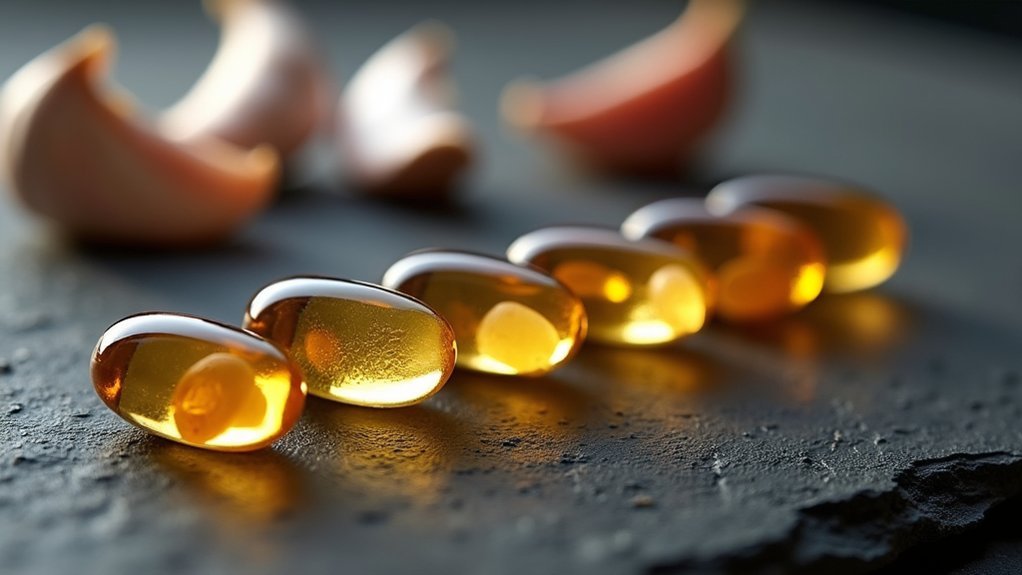You’ll maximize omega-3 absorption for joint healing by taking supplements in the morning on an empty stomach with 250-2,700mg daily dosing based on your inflammation levels. Combine them with fat-soluble vitamins E, D, and K to enhance bioavailability and anti-inflammatory effects. Choose high-quality sources like wild-caught fatty fish or premium supplements, support your gut health with probiotics, and monitor your joint response through blood testing every 3-6 months. These strategies can boost absorption rates considerably and access deeper optimization techniques.
Optimize Omega-3 Timing and Dosage for Enhanced Joint Absorption

When should you take omega-3 supplements to maximize their joint-healing potential? Morning consumption on an empty stomach provides ideal absorption rates, setting your body up for enhanced functioning throughout the day.
Take omega-3 supplements in the morning on an empty stomach for optimal absorption and enhanced daily joint function.
You’ll want to avoid taking supplements immediately before or after heavy meals, as this can interfere with proper digestion and nutrient uptake.
For dosage, healthy adults need a minimum of 250-500mg combined EPA and DHA daily. However, if you’re managing arthritis or significant joint inflammation, you may benefit from higher doses up to 2,700mg per day. When selecting supplements, be sure to check the actual EPA and DHA levels rather than just the total fish oil content.
Remember to maintain adequate water intake, as proper hydration is essential for omega-3 absorption. Consistency matters most—taking your supplements at the same time daily helps maintain steady levels for ideal joint health benefits.
Combine Omega-3s With Fat-Soluble Vitamins to Boost Bioavailability
Although omega-3 supplements alone provide significant joint benefits, you’ll dramatically improve their absorption by combining them with specific fat-soluble vitamins. Fat-soluble vitamins create synergistic effects that enhance omega-3 bioavailability and protect these delicate fatty acids from oxidative damage.
| Vitamin | Absorption Benefit | Joint Impact |
|---|---|---|
| Vitamin E | Protects omega-3s from oxidation | Enhanced anti-inflammatory effects |
| Vitamin D | Supports calcium absorption | Improved bone-joint integration |
| Vitamin K | Aids protein synthesis | Better cartilage maintenance |
Vitamin E acts as your omega-3’s bodyguard, preventing oxidation that can reduce their effectiveness. When you take these vitamins together with meals containing healthy fats, you’ll maximize absorption through natural digestive processes. This combination approach guarantees your joint-healing nutrients work together rather than competing for absorption. Since conversion efficiency from plant-based omega-3s to the active forms your joints need is naturally low, optimizing absorption becomes even more critical for therapeutic benefits.
Choose High-Quality Omega-3 Sources for Maximum Anti-Inflammatory Impact

Your body’s anti-inflammatory response depends heavily on the quality and type of omega-3 sources you choose.
Fatty fish deliver the most potent anti-inflammatory compounds, with mackerel leading at 2,600 mg of EPA and DHA per 100g, followed by salmon and herring at 2,150 mg each. Sardines provide 1,400 mg and offer excellent value.
If you’re choosing supplements, cod liver oil delivers 2,438 mg per tablespoon, while krill oil offers enhanced absorption.
For plant-based options, chia seeds, flaxseeds, and walnuts provide ALA omega-3s. These plant sources require conversion by your body to create the EPA and DHA forms that provide direct anti-inflammatory benefits.
Processing matters greatly. Canned salmon retains more omega-3s than tuna, while smoking preserves nutritional value better than freezing.
Choose wild-caught fish when possible, as farmed varieties often contain lower omega-3 levels due to feed differences.
Support Digestive Health to Improve Omega-3 Uptake and Utilization
Getting the highest-quality omega-3s won’t matter if your digestive system can’t properly absorb and utilize them. Your gut microbiome plays an essential role in omega-3 metabolism, with beneficial bacteria helping produce anti-inflammatory compounds like short-chain fatty acids and butyrate.
A healthy gut microbiome is essential for proper omega-3 absorption and maximizing their anti-inflammatory benefits in your body.
You’ll enhance omega-3 absorption by diversifying your gut bacteria through prebiotic fiber consumption and probiotic supplementation. These beneficial microbes directly utilize omega-3s to create metabolites that support intestinal wall integrity and reduce inflammation.
Maintain ideal digestive health by staying adequately hydrated, following a balanced nutrient-rich diet, and avoiding gut irritants like excessive alcohol and inflammatory foods. Higher omega-3 levels also correlate with elevated NCG production, which may reduce oxidative stress and further improve gut function.
A healthy gut microbiome doesn’t just improve omega-3 uptake—it amplifies their anti-inflammatory effects throughout your body, maximizing joint-healing benefits.
Monitor Joint Response and Adjust Omega-3 Intake for Optimal Results

Since omega-3 absorption varies considerably between individuals, you’ll need to track your body’s response and fine-tune your intake for peak joint-healing benefits.
Blood testing provides the most accurate method to assess your omega-3 levels and absorption efficiency. Gas chromatography and liquid chromatography can measure specific fatty acids in your plasma, revealing how well your body incorporates these nutrients.
Monitor your progress through these key indicators:
- Joint pain and inflammation symptoms – Track daily discomfort levels and functional improvements
- Blood omega-3 biomarkers – Test plasma phospholipid levels every 3-6 months to confirm adequate absorption
- Inflammatory markers – Monitor cytokine levels and other biochemical indicators of joint inflammation
For optimal joint healing, maintain a balanced ω-3/ω-6 ratio between 3:1 to 4:1, as this proportion is crucial for preventing chronic inflammatory diseases that can worsen joint conditions.
Adjust your dosage gradually based on these results, considering your individual metabolic rate and digestive function for peak joint repair.
Frequently Asked Questions
Can I Take Omega-3 Supplements if I’m on Blood Thinning Medications?
You can take omega-3 supplements with blood thinners, but you’ll need your doctor’s approval first. High doses may increase bleeding risk, so stick to moderate amounts and monitor for excessive bleeding signs.
How Long Before I See Joint Pain Improvement From Omega-3 Supplementation?
You’ll typically notice joint pain improvement after 8-12 weeks of consistent omega-3 supplementation. Some mild inflammation reduction may appear within days, but significant pain relief requires months of continuous intake for measurable benefits.
Are Plant-Based Omega-3s as Effective as Fish Oil for Joint Health?
Plant-based omega-3s aren’t as effective as fish oil for joint health. Your body must convert ALA to EPA and DHA inefficiently. You’ll get better results from fish oil or algae-based supplements.
Should I Stop Omega-3s Before Surgery or Medical Procedures?
You should discuss omega-3 cessation with your surgical team. While traditional guidelines recommend stopping fish oil before surgery, recent evidence suggests bleeding risks may be overestimated for most procedures.
Can Children Safely Take Omega-3 Supplements for Joint Support?
Yes, children can safely take omega-3 supplements for joint support when you follow age-appropriate dosages. You’ll want to consult your pediatrician first and choose high-quality, purified supplements specifically formulated for children.
In Summary
You’ll maximize your joint-healing benefits by timing your omega-3 intake strategically and pairing it with fat-soluble vitamins. Don’t overlook digestive health—it’s essential for proper absorption. Choose premium omega-3 sources and consistently monitor how your joints respond. Adjust your dosage based on your body’s feedback. Remember, you’re building an all-encompassing approach that works synergistically. Stay consistent with these strategies, and you’ll see improved joint comfort and mobility over time.





Leave a Reply